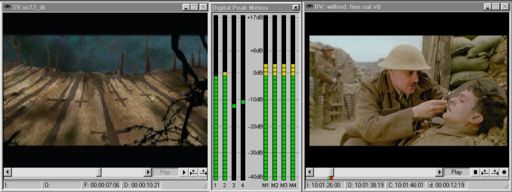|
|
|
The Digital Process Explained
Wilfred is the first UK 35mm film in its entirety to have used the new digital intermediate process but what does that mean?
|
|
|
|
|
The Process
Wilfred was shot on 35mm Film stock just like any other cinema film. Filmed in the normal way, the rushes were then telecined onto Beta tape for off-line editing (Discreet - Edit*). The EDL (Edit Decision List) created was then used by the negative cutter to assemble a reel of cut material with 20 frame "handles" at the beginning / end of each shot. The film was then graded with Da Vinci and scanned at high resolution on the Spirit Datacine. Transferred to Inferno*, the film was assembled, and effects and titles applied. The data was then re-recorded onto colour negative film from which a release print was made.
|
|
|

|
|
|
|
The Inferno* allows limitless changes to speed, freeze frames, dissolves, dips to colour, wipes, multi layers and the reuse of material. Most "optical" effects, like these are part of the automatic conforming process. A trailer and teaser can be cut from first generation film footage.
|
|
|
|

|
|

|

|

|

|
|
Grading
Full control over the grading, is supervised by the Director & Cinematographer. The process is similar to normal telecine work, but colour is corrected in 2k onPandora Megadef and displayed on a high definition monitor. The material is viewed in real time and 'in shot' or dissolved gradings are possible. Colour effects like secondaries, windows, de-saturation, tinting, separations etc. as optical filters are all part of the toolbox.
|
|
|
|
Formats
The process, at present, accepts several formats and to freely mix between them. Super 35mm can be scanned and recorded to produce a standard anamorphic print - DigitalScope (2:35) without the need of an optical "blow-up". Super 16mm can also be scanned full frame and recorded academy on the resulting intermediate stock.
16mm can be mixed with 35mm as well as video formats. 35mm 3-perf. is also acceptable. The format used through the system, for the first time is based purely on the filmmakers decision.
|
|
|
|
|
Effects
The large Inferno* workstations can assemble a feature film in its entire length and provides the industry's most advanced tool kit for compositing, effects and image enhancement. Animated graphic title sequences and credits are obvious. Pre-prepared graphics from artists in the field or 3D animators can be imported for fast compositing in context with the rest of the film. For Wilfred Discreet's Flame* and Combustion* was used for additional graphic work.
|
|
|
|
|

|
|
|
|
|
Film Re-recording and Back-up
Laser recording technology provides tremendous speed and quality to the process. The Arri Laser can not only record several 1st generation inter-negatives but also inter-positives for international high-volume distribution. A set of high-speed back-up tapes now represent the original digital negative and the data can later be migrated to other formats. The time frame for a re-recording of a feature film onto a new negative is 5-10 days.
|
|
|
|
Other format Outputs
A set of digital video masters (16:9 and 4:3 aspect) is produced from the data. This gives an unequalled clean and crisp quality, especially suitable for DVD compression. the new D6 (Voodoo) HD uncompressed 24p format generates a very crisp and clean HD master. From this master any format can be produced: HDTV, SDTV (NTSC, PAL, 16:9, 4:3) for future electronic cinema projections.
|
|
|
|

